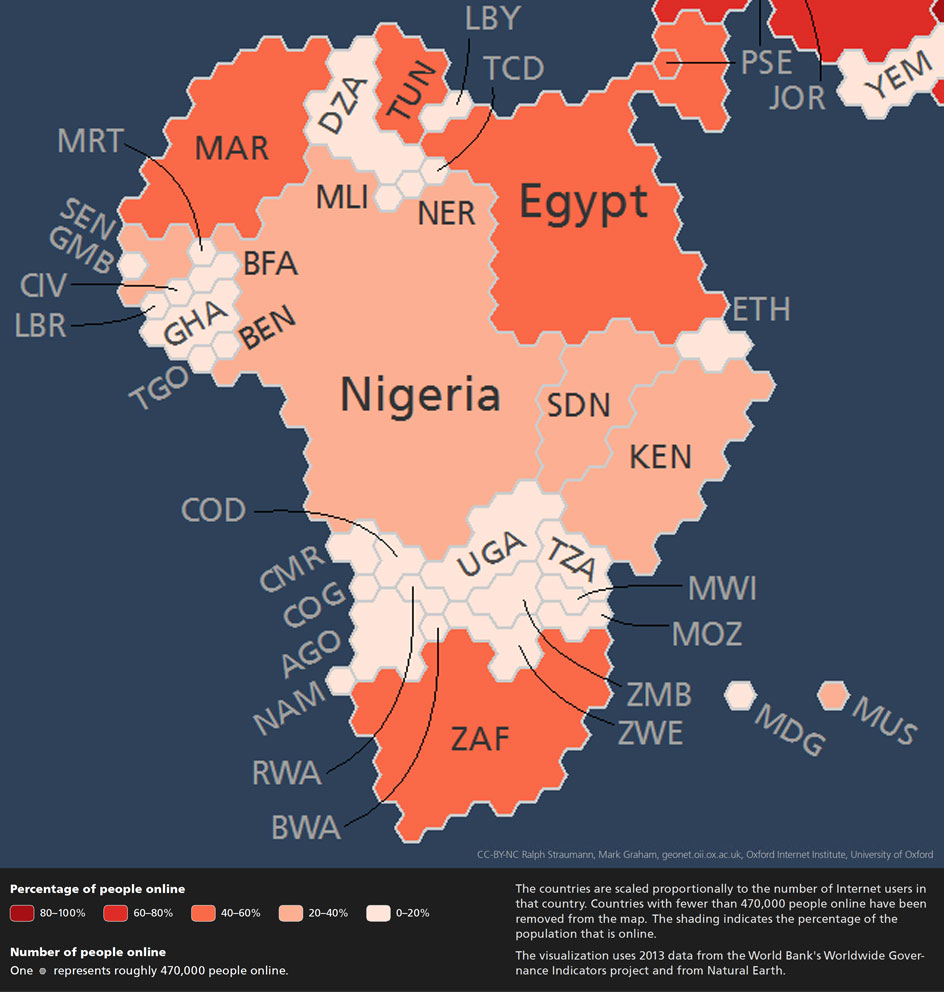
Internet penetration between 2009 and 2013 per world region (click for larger version)
Our previous mappings showed that access to the internet is highly uneven, leaving large swaths of the world in a state of disconnection. In this post, a different kind of visualisation allows us to focus on both the state and the strength of growth of internet access in different countries.

Africa’s internet population. This map is an excerpt made by Mathieu Olivier from our original internet population map.
From the visualisation, we can see that countries in Sub-Saharan Africa (SSA) mostly find themselves mostly in the lowest third of internet penetration. We can further see that the situation in SSA was more uniform in 2009 than in 2013; several countries have seen a steep rise in internet penetration.
The countries in SSA with the fastest growth in internet penetration (in terms of percentage points) are, in descending order, South Africa, Kenya, and Nigeria. These countries are also the countries with the largest internet populations in SSA, as can be seen from the map on the right.
The visualisation further shows that Asia and the Middle East & North Africa (MENA) and, to a lesser extent, Latin America & Caribbean (LACA) are the regions that feature countries both near the top and near the bottom in internet penetration.
Europe actually stands out as the only region that has a more uniform distribution of internet penetration in 2013 compared to 2009. In all other regions we see growing disparities, where the gulf between the respectively most and least connected countries has grown.
Sub-Saharan Africa’s and Europe’s internet penetration rates are so dissimilar that there is only a very small overlap in 2013. From the most to the least connected this overlap encompasses: Seychelles, Romania, South Africa, Moldova, and Ukraine. Looking at the distributions, it becomes clear that particularly the countries in Sub-Saharan Africa in this group are conspicuous outliers in their region.
Focusing on growth in internet penetration, we consider the steepness of the lines in the visualisation. With the exception of North America, we find that all regions feature at least some countries with a similarly spectacular growth rate in terms of percentage points. However, upon closer inspection, it is only in Asia and Sub-Saharan Africa that fast growth has happened in countries that had low internet penetrations in 2009. This development was led by South Africa, Kenya, and Nigeria (starting out from 10–20% internet penetration) in Sub-Saharan Africa, and the Central Asian countries of Kazakhstan, Azerbaijan, and Armenia (starting out from around 15–25% internet penetration).
In LACA and MENA, the countries gaining internet penetration the fastest as a tendency already had intermediate internet penetration within their region in 2009, starting out from between 34% and 42% (LACA) and 27% and 53% (MENA). Lesser connected countries in these regions do also have growing internet penetration, but not quite at these same rates.
Here we list the most and the least connected connected countries as well as the countries experiencing the fastest gain in internet penetration between 2009 and 2013 (excluding particularly small countries with fewer than a quarter million inhabitants):
Sub-Saharan Africa
Most connected: South Africa, Kenya, Mauritius
Least connected: Somalia, Burundi, Eritrea
Fastest growth: South Africa, Kenya, Nigeria
Asia
Most connected: Japan, South Korea, Hong Kong
Least connected: Myanmar, Timor-Leste, North Korea
Fastest growth: Kazakhstan, Azerbaijan, Armenia
Europe
Most connected: Iceland, Norway, Sweden
Least connected: Romania, Moldova, Ukraine
Fastest growth: Russia, Bosnia and Herzegovina, Belarus
Latin America & Caribbean
Most connected: Barbados, Puerto Rico, Bahamas
Least connected: Honduras, Nicaragua, Haiti
Fastest growth: Bahamas, Puerto Rico, Argentina
Middle East & North Africa
Most connected: Bahrain, United Arab Emirates, Qatar
Least connected: Libya, Djibouti, Iraq
Fastest growth: Lebanon, Oman, Bahrain
North America
From most to least connected: Bermuda, Canada, United States, Greenland
Fastest growth: United States, Bermuda, Canada
Oceania
Most connected: Australia, New Zealand, New Caledonia
Least connected: Vanuatu, Solomon Islands, Papua New Guinea
Fastest growth: New Caledonia, Fiji, French Polynesia